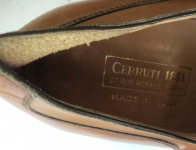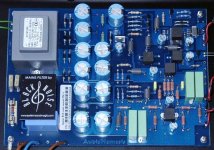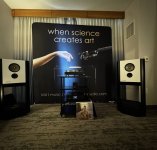AT-HA26D DAconverter for 24bit 192kHz
And modify and upgrade everything inside, or use Broskie unbalancer...
It will be a solid piece of gear after much modifications
And modify and upgrade everything inside, or use Broskie unbalancer...
It will be a solid piece of gear after much modifications
Miles Davis - Kind of Blue is an absolute cherry. It has restrictions for me. I can not crank it up on big speakers and big amps, oh it is terrible!
On a small speaker system with low watts in a quiet room, it can be sublime. There is a massive amount of recorded material out there best played in such conditions.
Off topic but I saw those past comments...
On a small speaker system with low watts in a quiet room, it can be sublime. There is a massive amount of recorded material out there best played in such conditions.
Off topic but I saw those past comments...
AT-HA26D DAconverter for 24bit 192kHz
And modify and upgrade everything inside, or use Broskie unbalancer...
It will be a solid piece of gear after much modifications
Is this useful?
Still reliant upon a bunch of op-amps and a SMPS brick.
Last edited:
Racks of HiFi that cost as much as a car? Italian leather chairs?
The only thing I have made from Italian leather is some SPD cycling shoes.
I'm currently testing speakers, using a DVD player from a charity shop (£7), an amp bodged from an old DAB radio (powered by a phone charger), both sat on the floor.
Tomorrow, I'll bring a multi plug so I'll have another mains socket for my cheep Chinese DAC.
The only thing I have made from Italian leather is some SPD cycling shoes.
I'm currently testing speakers, using a DVD player from a charity shop (£7), an amp bodged from an old DAB radio (powered by a phone charger), both sat on the floor.
Tomorrow, I'll bring a multi plug so I'll have another mains socket for my cheep Chinese DAC.
Another DAC vs no DAC comparison test:
As the hosts admits, he is not an experimental scientist. Nonetheless, the results are the same as the previous video I posted: the vast majority of people cannot reliably hear the difference between an origital music signal and the siginal processed by an ADC and DAC. The host did not go into statistics on the results, but statistically speaking some people will guess correctly.
Is the test perfect? No. But, this test and the test conducted in the other video to which I linked previously is more evidence that good quality DACs, even budget priced ones, are transparent. Certainly more evidence than I have seen to support assertions of the contrary. To support the contrary, I only have seen subjective listening impressions in sighted listening tests. Personally, I give little weight to sighted listening tests due to expectation bias or, as some call it, the placebo effect (I understand some disagree with that term).
I am not saying that it is impossible for some people to hear a difference, it is just that I have not seen any evidence of that either in measurements or in a properly conducted blind listening tests. As I have stated, there are hypotheses, theories and speculation, but those are just that and not conclusive. I do keep an open mind, however, and I will consider other test results that become available.
As the hosts admits, he is not an experimental scientist. Nonetheless, the results are the same as the previous video I posted: the vast majority of people cannot reliably hear the difference between an origital music signal and the siginal processed by an ADC and DAC. The host did not go into statistics on the results, but statistically speaking some people will guess correctly.
Is the test perfect? No. But, this test and the test conducted in the other video to which I linked previously is more evidence that good quality DACs, even budget priced ones, are transparent. Certainly more evidence than I have seen to support assertions of the contrary. To support the contrary, I only have seen subjective listening impressions in sighted listening tests. Personally, I give little weight to sighted listening tests due to expectation bias or, as some call it, the placebo effect (I understand some disagree with that term).
I am not saying that it is impossible for some people to hear a difference, it is just that I have not seen any evidence of that either in measurements or in a properly conducted blind listening tests. As I have stated, there are hypotheses, theories and speculation, but those are just that and not conclusive. I do keep an open mind, however, and I will consider other test results that become available.
Last edited:
I am not going to bother trying to count cuts. However, even in the youtube sound played back on my laptop on $20 headphones there seems to be some changes in the texture of the guitar chords (didn't bother getting the wav file and or taking over to the good system). The textures go from sounding mellow and smooth, to sounding very slightly fizzy ugly crunch distorted (kind of like just a tiny little bit roughed up with some sandpaper), and then back to smooth and mellow. Remember, its a rather slight change in the youtube sound, so don't expect too much. Doesn't anyone else hear that? Don't get distracted by trying to keep count, just listen for the slight fizzy distortion on the guitar chord texture then back to smooth and mellow. If you can memorize a difference then you have a chance of not missing any cuts....good quality DACs, even budget priced ones, are transparent.
Last edited:
I think "a properly conducted blind listening test" is the key phrase. I have very little interest in these kind of tests, but when I did evaluate listening test procedures a while back I seem to remember that the best results in hearing differences were with extremely familiar material and with acoustic instruments. "Extremely familiar" requires a lot more work to set up for the subjects involved, and may also require a lot of repeats. Listening tests need to be optimised to follow the procedures that have shown the most reliable differences. Otherwise it's just rubbish in, rubbish out.
That's how I proceed when being alone to test, with a lot of known materials. I also rely only on the first 30 minutes of listening at each test, before the brain gets the habit of spl and lowish/flat the spl...
The traditional Italian manufacturing industry still exists, but is very much subject to erosion.Racks of HiFi that cost as much as a car? Italian leather chairs?
The only thing I have made from Italian leather is some SPD cycling shoes.
I'm currently testing speakers, using a DVD player from a charity shop (£7), an amp bodged from an old DAB radio (powered by a phone charger), both sat on the floor.
Tomorrow, I'll bring a multi plug so I'll have another mains socket for my cheep Chinese DAC.

The mass car manufacturers are almost gone (merged into Stellantis), but the (motor) bike industry is still flourishing and Italy leads the Pro Audio loudspeaker driver market.
There are also still a significant number of Italian hi-fi manufacturers.
Almost all well-known hi-fi products are characterized by a very specific, romantic signature and feedback is a dirty word for most amplifier manufacturers.
A small one-man project, completely handmade according to Ryohei Kusunoki's NOS philosophy.
Now 20 years old, but sounds better than more modern small DACs I own, including the V-DAC II and the Topping D10s.

Here the original Yamamoto Tube dac review: https://6moons.com/audioreviews/yamamoto8/dac.html
The Dac section is inspired by the Kaneda dac, the multiples separate supplies and the tube output are pure Yamamoto.
The original uses very basic IC film output coupling caps. Mine uses first Clarity Caps and it was very good, then the Duelund were way better. Mine also uses separate smaller power transformers, slightly different tube output section and 6N single crystal/teflon wirings. I made my own enclosure, with Furutech AC inlet, custom noise filter, and WBT netxgen RCA output connectors.
As the Audionote the choices of parts, caps, etc, has an impact on the final sound.
SB
The Dac section is inspired by the Kaneda dac, the multiples separate supplies and the tube output are pure Yamamoto.
The original uses very basic IC film output coupling caps. Mine uses first Clarity Caps and it was very good, then the Duelund were way better. Mine also uses separate smaller power transformers, slightly different tube output section and 6N single crystal/teflon wirings. I made my own enclosure, with Furutech AC inlet, custom noise filter, and WBT netxgen RCA output connectors.
As the Audionote the choices of parts, caps, etc, has an impact on the final sound.
SB
That is an excellent point! Experience will lead a person to such knowledge. People talking, smoking, drinking and eating are not good for listening sessions. Sure it is fun and probably one of the the best parts but not for critical listening.I also rely only on the first 30 minutes of listening at each test,
When one has truly great audio gears the difference isn’t subtle.
The difference with a top class ab transistor amp and a tube amp loaded with cathode feedback, lundhal custom transfo best nos tubes low thd , even with the tube amp being way more powerful and musical the transistor amp destroys it because it has no transformer phase rotations for each windings and it has way better slew rate , stability and current on demand , no tube noise and no windings thd and hysteresis
It should be the same with Dacs when properly executed
The parts names, wires , opamps or caps in the signal path is completely irrelevant once the real audio weaknesses of transistors has been properly addressed
The difference with a top class ab transistor amp and a tube amp loaded with cathode feedback, lundhal custom transfo best nos tubes low thd , even with the tube amp being way more powerful and musical the transistor amp destroys it because it has no transformer phase rotations for each windings and it has way better slew rate , stability and current on demand , no tube noise and no windings thd and hysteresis
It should be the same with Dacs when properly executed
The parts names, wires , opamps or caps in the signal path is completely irrelevant once the real audio weaknesses of transistors has been properly addressed
Maybe not always ideally so. Forward biased semiconductor junctions can act both as RF demodualtors and as modulators. If and when RF gets intermodulated with the audio signal and intermodulation products end up in the audio band then you can have audible problems. Also, to the extent such an RF signal consists of random noise, the effects can be hard, or sometimes very hard, to measure quantitatively....transistor amp destroys it...
That said, its also true that tube amps and some kinds of circuitry some people like to use for music listening can tend to add its own coloration, which may then tend mask more subtle upstream problems. In some cases that may be exactly the reason, or one of the reasons, for using such circuitry in the first place.
Last edited:
I agree, but I think it's good to make a distinction between purposeful listening during R&D and casual listening, possibly including 'substances'.That is an excellent point! Experience will lead a person to such knowledge. People talking, smoking, drinking and eating are not good for listening sessions. Sure it is fun and probably one of the the best parts but not for critical listening.
In the latter case I'm reminded of our lockdown parties where people, not necessarily sober, made explicit compliments about the sound, including people who play instruments or produce music themselves.
I still listen critically to certain systems where I feel potential is masked or overwhelmed by shortcomings, but if a setup actually encourages critical listening - which is the case with many high-end setups (especially those including Magico and similar speakers), I'm usually done within 30 seconds.
These are the systems that usually appeal to inexperienced listeners - those without a broadly developed frame of reference.
Usually these setups include, extremely complex, big amplifiers and source devices that deliver the 'fireworks' through the overdamped (often synthetic) drivers by means of loudness cues as a result of accumulated, miniscule non-linearities.
Last edited:
Below that is the class of modern, processing-based high-end stuff, such as this setup.

I remember the introduction of their streamer: killing time with anticipation while one of the guys explained all the details of the streamer, only to be disappointed when a few pre-selected tracks were finally played.
"When science creates art."
Art it may be, but it's not a 'natural' reproduction of music.
If someone were to consider such an active setup, I would personally recommend the Kii Seven, which sounds slightly better and is considerably cheaper.

I remember the introduction of their streamer: killing time with anticipation while one of the guys explained all the details of the streamer, only to be disappointed when a few pre-selected tracks were finally played.
"When science creates art."
Art it may be, but it's not a 'natural' reproduction of music.
If someone were to consider such an active setup, I would personally recommend the Kii Seven, which sounds slightly better and is considerably cheaper.
In my amp this has been addressed, there is quite a low feedback, in 3 different loops, the input is opamp,Maybe not always ideally so. Forward biased semiconductor junctions can act both as RF demodualtors and as modulators. If and when RF gets intermodulated with the audio signal and intermodulation products end up in the audio band then you can have audible problems. Also, to the extent such an RF signal consists of random noise, the effects can be hard, or sometimes very hard, to measure quantitatively.
That said, its also true that tube amps and some kinds of circuitry some people like to use for music listening can tend to add its own coloration, which may then tend mask more subtle upstream problems. In some cases that may be exactly the reason, or one of the reasons, for using such circuitry in the first place.
There are two specialized inductors to take care of feedback and stabilize the output stage , feedback is taken before the inductors , and filters for rolling off high frequencies
My tube amps are actually way more susceptible to this problem because they only have one pole set after the phase splitter
Tubes smooth out signals and add noise , that is why they work better with little to no feedback
The OT has hysteresis , power loss , lack of instant current , phase shifts like there is no tomorrow
They only have great gain performances , power , rugged, and wide open bandwidth,
- Home
- Source & Line
- Digital Line Level
- Are there any excellent inexpensive Chinese DACs?